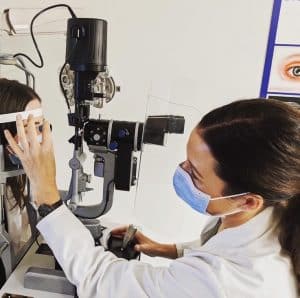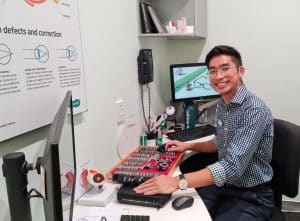Deciding to practise in a regional community can expose new optometrists to a variety of pathology and lifestyle opportunities. Two graduates discuss their decision to go regional, and the most important factors when it came to choosing their employer.
The year before Ms Nikki Hall embarked on a post-graduate optometry course at the University of Melbourne (UniMelb), her father suffered serious ocular trauma in a rural workplace accident.
He was fencing on their Porepunkah cattle farm in northeast Victoria when a piece of wire struck his eye. Being in a remote area, access to eyecare was limited. It’s an all too familiar story: her father was sent to three different hospitals, before eventually receiving care more than 12 hours later.
Many years earlier, Hall had completed a biomedical science degree at Deakin before working in research for two years, but she longed for a career with more face-to-face interaction. Her father’s eye injury was all the motivation she needed to pursue an optometry career, with the hope of one day returning to her rural roots to improve eyecare accessibility and inspire others into the industry.

Hall is now fulfilling this goal through a graduate position at Specsavers Wodonga, located on the Victorian side of the border with New South Wales, after graduating from her four-year UniMelb course in 2020.
“During my final year placement at Specsavers I noticed a higher volume of patients, so as a graduate I was excited to be exposed to a lot of different cases and pathology,” she says.
COVID reshaping graduate landscape
According to Mr Raj Sundarjee, director of professional recruitment at Specsavers Australia and New Zealand, Hall is among an increasing number of graduates choosing the rural lifestyle.
“There is no doubt that the graduate recruitment landscape in 2021 is being shaped by the impact of COVID-19 across Australia in the past year,” he says.
“While we aren’t seeing any reduction or difference in the number of graduates being placed in 2021 and we would have liked to have taken on many more, we are seeing more and more graduates join regional locations as the result of less movement and vacancies across metro locations.”
To address maldistribution demonstrated in its modelling, Specsavers has also been intentional in its placement of new graduates. Regional and rural graduates have more than doubled since 2018, with the figure now almost on par with the number of graduates employed in metro stores.
“As you would expect with ongoing border restrictions, interstate movement is also lower. However, positively we are seeing more students open to moving interstate as confidence in border stability grows in 2021,” Sundarjee says.
With this in mind, the company has been evolving its Graduate Program to match the changing optometry landscape. Sundarjee says Specsavers is proud of the initiative, which aims to deliver relevant content, opportunities and support to graduates over two-years.

“The Graduate Program’s dedicated focus on mentorship has never been more vital than over the past 12 months, providing a personal approach to professional development during those first few years as a qualified optometrist,” he says.
“This is complemented by in-store experience practising full-scope optometry to build upon knowledge and skills, as well as access to professional events, courses, experiences and a wide support network of peers and mentors. There is also a wealth of professional and personal benefits, including being part of an optometry team on the vanguard of clinical benchmarking and technology to deliver industry-leading health outcomes and prevent avoidable blindness.”
For Hall, mentorship played a major role in her choosing Specsavers.
In addition to a relocation allowance and bonus for choosing to work regionally, she was attracted to the franchise model consisting of a partner optometrist and partner dispenser, who offer input from the clinical and retail sides of the business.
“From an optometry perspective, I liked their clinical workflow, having access to pretesting information, as well as the use of OCT and visual fields made me feel more comfortable as a graduate optometrist,” she says.
“I’ve always wanted to move back to the country. Many rural areas can be at a disadvantage when it comes to accessibility to eyecare, it’s nice to feel like you’re contributing to something bigger.”
Basing herself in a regional practice, Hall can also extend her repertoire of skills beyond refraction. She’s seen multiple patients with foreign bodies, and cases of anterior uveitis, optic neuritis, retinal detachment, bilateral disc odema and Sjogren’s syndrome.
Choosing the Wodonga store has also meant she’s just an hour’s drive from her Porepunkah hometown. She’s also living with two graduate optometrists from her year who work in other practices in the area – they’ve become a useful sounding board when she returns from work.
Choosing regional over metro
After a disrupted year of learning in 2020, recent graduate optometrist Mr Liam Hua placed a greater emphasis on finding an employer who could provide substantial support for his transition into the workforce.
He had offers from other corporates and regional independents, but Specsavers’ mentorship program is what prompted him to accept a position at the company’s Mt Gambier store in South Australia, which has a population of around 28,300.

“I did my placement there and really liked the team, and the community was the type of rural town I was looking for,” he says.
“The mentor program on offer was also appealing in that it was very structured and organised. I felt I needed that extra support after COVID disrupted my learning. The program goes for two years, and you have a senior optometrist in the store to support and guide you, providing advice on certain clinical scenarios and other aspects.”
After completing placements during his final year of post-graduate studies at Flinders University, Hua says it became clear he wanted to work in a regional practice. Like Hall, he was keen to use his full set of skills in a practice with a high patient load. He also knew it would make him available to a larger pool of employers.
“I wasn’t opposed to going to metro areas, but I wanted to develop my skills and clinical acumen further, and in the city, I was sceptical as to whether I’d be able to do that to the same degree,” he says.
“It was about making sure I practise the skills I learned from university. The scale is quite intense because we service a 50km radius at least, so that’s a lot of patients, pathology, and interesting cases. Decision making is something I also struggled with at university – that was another reason why I leaned toward rural practice, because I’m keen to develop that aspect of being an optometrist.”
Although he wasn’t purely financially motivated, he says the salary was competitive to offers he received from other regional practices. But he was particularly impressed with the responsiveness of the recruiters who provided clarity around such an important decision.
“The recruiter I had was very organised and proactive. They had answers when I needed them, compared perhaps to some other experiences I had. I liked having that level of organisation and response,” he explains.
From a personal point of view, Hua was also ready to be independent and move away from Adelaide where he was raised and studied: “I wanted to be close enough to home where it’s just a drive away (4.5 hours) if I really needed it, but not close enough where I would drive back every weekend, so it was good from a personal development point of view as well.”
He also wasn’t sure what would happen to his social life, but he has been pleasantly surprised with how easily he has integrated into the regional way of life.
“It’s been better than I was expecting which is really nice. I thought it would be a lot harder to meet friends, but I was very fortunate to have a welcoming roommate, a solid community of young professionals, and other people like the Specsavers team who have been supportive and made the transition a lot easier,” he says.
“I actually haven’t had a dull weekend yet. I thought I’d be spending more weekends in at home, but I’ve been out and about, hikes, wild berry picking, BBQs and pubs – I’m probably more socially active here than I was in Adelaide, which is crazy to think.”
More reading
Supply debate reignites as optometry boasts strong employment rate




